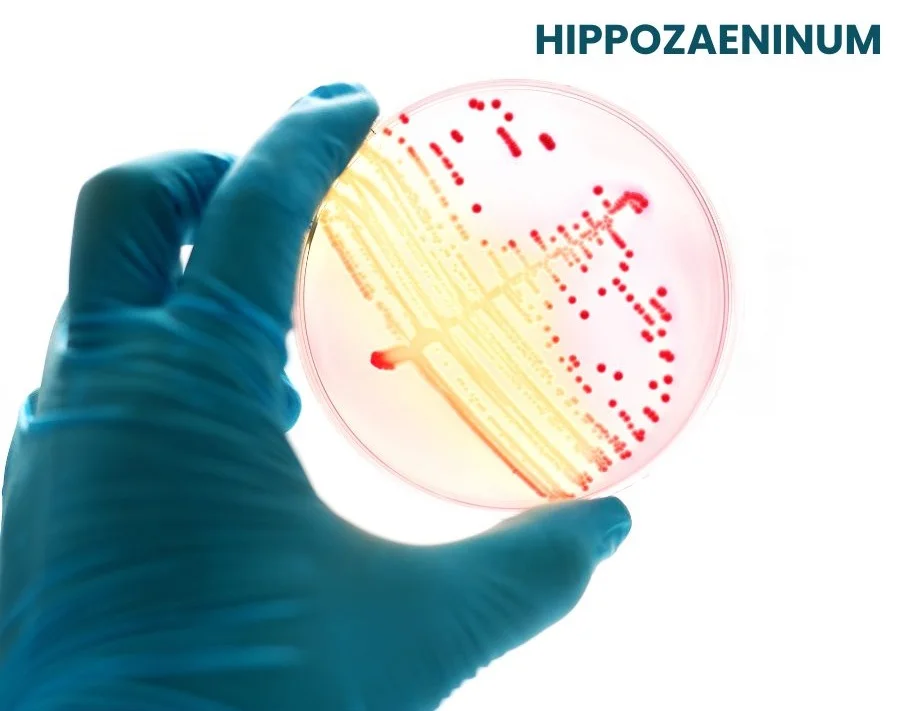Hippozaeninum is a nosode prepared from the infectious material of glanders, a bacterial disease affecting horses and sometimes humans.
It is utilized in homeopathy for conditions resembling glanders and related infections, offering potential therapeutic benefits for a variety of symptoms.

Table of Contents
ToggleSOURCE INFORMATION
Scientific Classification
- Kingdom: Bacteria (Nosode)
- Family: Nosodae
- Genus: Hippozaenium
Origin and Historical Facts
- Hippozaeninum, also known as Hippozaenium, is a nosode introduced by Dr. J. J. Garth Wilkinson.
- Nosodes are preparations made from pathological tissues or disease products.
- In the case of Hippozaeninum, it is derived from the infectious agents associated with glanders, a bacterial disease primarily affecting horses caused by Burkholderia mallei.
- Glanders can also affect humans, primarily through contact with infected animals.
- Historically, glanders has been a significant disease among horses, and its study has contributed to understanding infectious diseases and the development of nosodes in homeopathy.
- Dr. Wilkinson’s introduction of Hippozaeninum aimed to capture symptoms related to conditions like consumption (tuberculosis), cancer, and syphilis, suggesting a broad range of applications in homeopathic treatment.
Homoeopathic Application
In homeopathy, Hippozaeninum is used primarily for conditions that manifest symptoms similar to those associated with glanders and related infections.
These conditions may include:
- Ozona (a form of nasal discharge)
- Scrofulous swellings (enlarged lymph nodes)
- Pyaemia (pus in the blood)
- Erysipelas (skin infection)
- Chronic rhinitis (chronic nasal inflammation)
- Saneous secretion (possibly referring to foul-smelling discharges)
DRUG PATHOGENESIS
- Hippozaeninum affects various systems in the body, primarily manifesting in the respiratory system, skin, and glands.
KEY CHARACTERISTICS
- Nose: Red, swollen with acrid, bloody discharge. Ulceration and tubercles.
- Face: Swollen glands leading to painful abscesses.
- Respiratory System: Hoarseness, bronchial asthma, noisy and irregular breathing patterns, excessive mucus secretion leading to suffocation risks.
- Skin: Various swellings, nodules, pustules, abscesses, ulcers, and inflammatory conditions.
DETAILED ORGAN SYMPTOMS
NOSE
- Red, Swollen Nasal Passages: Inflammation causing redness and swelling inside the nose.
- Catarrh: Excessive mucus production.
- Ozona: Foul-smelling nasal discharge.
- Ulceration with Acrid, Corroding, Bloody, Offensive Discharge: Painful sores inside the nose that secrete a harmful, bloody, and foul-smelling fluid.
- Tubercles on Nasal Septum: Small nodules forming on the nasal septum (alae nasi).
- Papules and Ulceration in Frontal Sinus and Pharynx: Small raised bumps and sores in the frontal sinus and throat area.
FACE
- Swollen Glands Throughout the Face: Enlarged and painful glands in the facial region.
- Painful Abscess Formation: Development of pus-filled pockets within the facial tissues.
RESPIRATORY SYSTEM
- Hoarseness of Voice: Rough or strained voice.
- Bronchial Asthma: Asthmatic symptoms involving the bronchial tubes.
- Noisy, Short, Irregular Breathing: Labored and uneven breathing patterns.
- Cough with Dyspepsia: Coughing that accompanies indigestion.
- Excessive Secretion of Mucus: Overproduction of mucus in the respiratory tract.
- Imminent Suffocation Due to Bronchitis and Excessive Mucus Secretion: Severe risk of suffocation due to mucus buildup, particularly in the elderly.
- Potential Involvement in Tuberculosis Cases: Symptoms indicative of possible tuberculosis infection.
SKIN
- Swellings of Lymph Nodes: Enlarged lymph nodes.
- Articular Non-Fluctuating Swellings: Swelling in the joints that remains constant and does not fluctuate.
- Nodules in the Arm: Hard lumps under the skin of the arm.
- Malignant Erysipelas: Severe and potentially dangerous skin infection.
- Pustules, Abscesses, and Ulcers: Formation of pus-filled bumps, deep pockets of infection, and open sores.
- Rupia: Lesions on the skin that form crusty scabs.
- Eczema: Chronic inflammatory skin condition causing redness, itching, and blistering.
RELATIONSHIP WITH OTHER DRUGS
Compare with:
- Muco-toxin: Similar in treating mucous catarrhs.
- Aurum (Gold): For its effect on glandular swellings.
- Kali bichromicum: Known for treating respiratory and nasal conditions.
- Psorinum: Nosode for chronic infections.
- Bacillinum: Nosode for respiratory and glandular conditions.
DOSE
- Thirtieth potency is recommended.
Frequently Asked Questions
What conditions is Hippozaeninum used for in homeopathy?
- It is used for conditions resembling glanders and related infections, including nasal discharge, respiratory issues with excessive mucus, skin infections, and glandular swellings.
How does Hippozaeninum affect the respiratory system?
- It can cause hoarseness, bronchial asthma, noisy breathing, irregular breath patterns, and imminent suffocation due to excessive mucus secretion.
What are the key skin symptoms treated by Hippozaeninum?
- It addresses lymphatic swellings, nodules, pustules, abscesses, ulcers, and inflammatory skin conditions like eczema and erysipelas.
Glossary of Difficult Words
- Ozona: A form of nasal discharge.
- Pyaemia: Presence of pus in the blood.
- Erysipelas: A bacterial skin infection.
- Nosodes: A homeopathic preparation from disease products.
- Catarrh: Inflammation of mucous membranes with excessive discharge.
- Tubercles: Small nodular lesions.
- Bronchial asthma: Chronic inflammatory disease of the airways.
- Dyspepsia: Indigestion.
- Articular: Relating to joints.
- Rupia: Skin disease with ulceration and scab formation.
